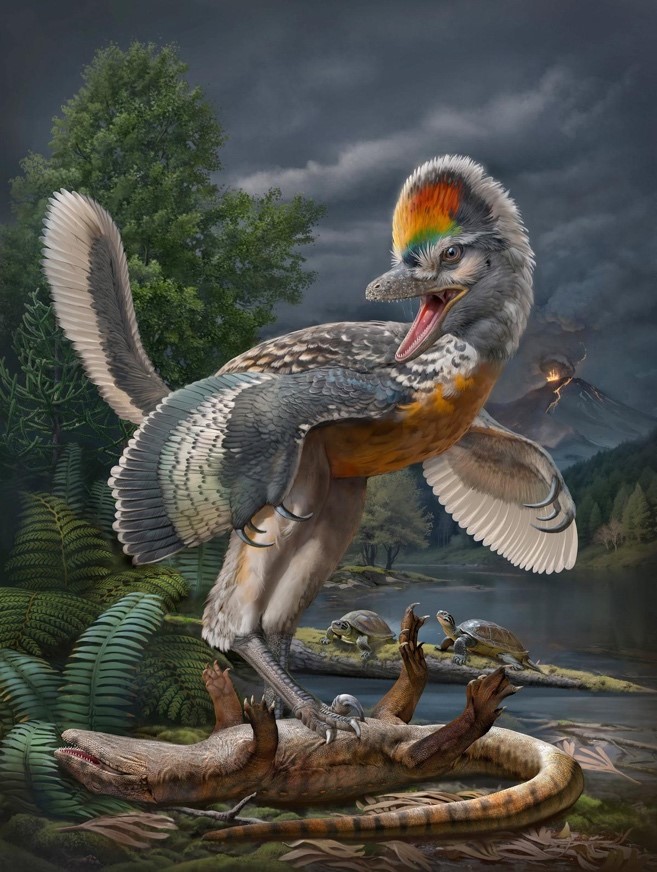Description

Disclaimer: Copyright infringement not intended.
Context
- The recent discovery of the bird-like dinosaur Fujianvenator prodigiosus in Fujian Province, southeastern China, has sparked fascination among scientists and provides valuable insights into the evolutionary history of birds.
Details
Discovery and Fossil Characteristics
- The fossil of Fujianvenator prodigiosus, dating back to approximately 148 to 150 million years ago during the Jurassic Period, was unearthed in Fujian Province.
- This dinosaur exhibited peculiar characteristics, resembling a pheasant-sized creature with elongated legs and arms that were structured similarly to wings, raising questions about its lifestyle and locomotion.
Evolutionary Significance
- Fujianvenator prodigiosus offers valuable information about an essential stage in the evolutionary lineage of birds.
- The classification of Fujianvenator as a bird depends on the definition one uses for what constitutes a bird, as it possesses a mix of skeletal features that challenge conventional categorization.
Evolution of Birds from Theropods
- Birds evolved from small, feathered, two-legged dinosaurs known as theropods during the late Jurassic period.
- Archaeopteryx, the oldest-known bird, dates back to approximately 150 million years ago in Germany.
Membership in Avialans
- Fujianvenator is classified within the avialans group, which encompasses all birds and their closest non-avian dinosaur relatives.
- Despite their humble beginnings, birds survived the mass extinction event caused by an asteroid impact 66 million years ago, while their non-avian dinosaur counterparts did not.
Fossil Completeness and Limitations
- The Fujianvenator fossil, discovered in October, is reasonably complete, although it lacks the skull and certain parts of its feet, making it challenging to determine aspects of its diet and lifestyle.
- Notably, its lower leg bone (tibia) is twice as long as its thigh bone (femur), a unique characteristic among theropods, and it possessed a long bony tail.
Flight Capability
- Fujianvenator's forelimbs are structured similarly to a bird's wing but feature three claws on the fingers, a feature absent in modern birds.
- The ability of Fujianvenator to fly remains uncertain due to the absence of direct evidence in the fossil. However, its closest relatives and most avialan theropods are known to have had feathers, suggesting the possibility that Fujianvenator could have been feathered.
A Missing Chapter in Bird Evolution
- The discovery contributes to our understanding of the origin of birds and non-avian dinosaurs with bird-like characteristics.
- The early chapters of bird evolution remain obscure due to a lack of fossils. After Archaeopteryx, there is a gap of approximately 20 million years in the fossil record before the next appearance of birds.
.jpg)
Avialans
Avialans are a diverse group of creatures in the realm of paleontology and evolutionary biology. These organisms hold a pivotal place in the history of life on Earth, particularly because they encompass not only all modern birds but also their closest non-avian dinosaur relatives.
Definition of Avialans
- Avialans are a group of theropod dinosaurs characterized by the presence of feathers or feather-like structures, which set them apart from other dinosaur groups.
- The term "avialan" is derived from the Latin word "avis," meaning bird, reflecting their close association with the evolutionary lineage of birds.
Evolutionary Significance
- Avialans represent a crucial link in the evolutionary chain from theropod dinosaurs to modern birds.
- They provide insight into the transition from ground-dwelling, reptilian ancestors to the development of flight and the avian features seen in modern birds.
Key Features of Avialans
- Feathers: The presence of feathers or feather-like structures is a defining characteristic of avialans. These feathers played a pivotal role in the evolution of flight.
- Asymmetrical Flight Feathers: Many avialans possess asymmetrical feathers on their wings, a feature critical for achieving powered flight.
- Hollow Bones: Avialans typically have hollow bones, which reduce overall body weight, aiding in flight.
Archaeopteryx and Early Avialans
- The fossil record of early avialans is primarily documented through creatures like Archaeopteryx, which lived approximately 150 million years ago during the Jurassic Period.
- Archaeopteryx is often considered a transitional form between non-avian dinosaurs and modern birds, as it exhibits characteristics of both groups.
Avialans and Modern Birds
- All modern birds are avialans, belonging to the subgroup called Neornithes.
- Neornithes emerged during the Cretaceous Period and rapidly diversified, giving rise to the vast array of bird species present today.
Diversity of Avialans
- Avialans are not limited to just one branch of the dinosaur family tree; they encompass several subgroups, each with its unique features and adaptations.
- These include groups like Enantiornithes, which existed alongside modern birds but ultimately went extinct, and Confuciusornithidae, known for their toothed beaks.
Flight Evolution
- The evolution of flight in avialans is a complex process that involved numerous adaptations over millions of years.
- Early avialans may have been gliders, gradually developing the ability to sustain powered flight through changes in wing structure, feather morphology, and adaptations in their respiratory systems.
Significance for Science
- The study of avialans is critical for understanding the origin of birds, the evolution of flight, and the broader context of dinosaur diversity.
- These creatures provide valuable insights into how evolutionary processes have shaped life on Earth.
Ongoing Research
- Paleontologists continue to discover new avialan fossils, shedding light on previously unknown species and filling gaps in our understanding of avian evolution.
- Advanced imaging techniques and genetic studies further enhance our understanding of the relationships between avialans and modern birds.

Conclusion
In summary, the Fujianvenator prodigiosus discovery is a fascinating addition to our understanding of the evolutionary history of birds. It sheds light on the complex transition from theropod dinosaurs to birds and underscores the need for further research to uncover the missing chapters in the early history of avian evolution.
|
PRACTICE QUESTION
Q. Which of the following statements is true about Fujianvenator prodigiosus?
A) It was discovered in South America.
B) It is a herbivorous dinosaur.
C) Fujianvenator is a member of the avian dinosaur lineage.
D) It is closely related to Tyrannosaurus rex.
Answer: C)
|
https://www.thehindu.com/sci-tech/science/bizarre-bird-like-dinosaur-has-scientists-enthralled/article67278504.ece











